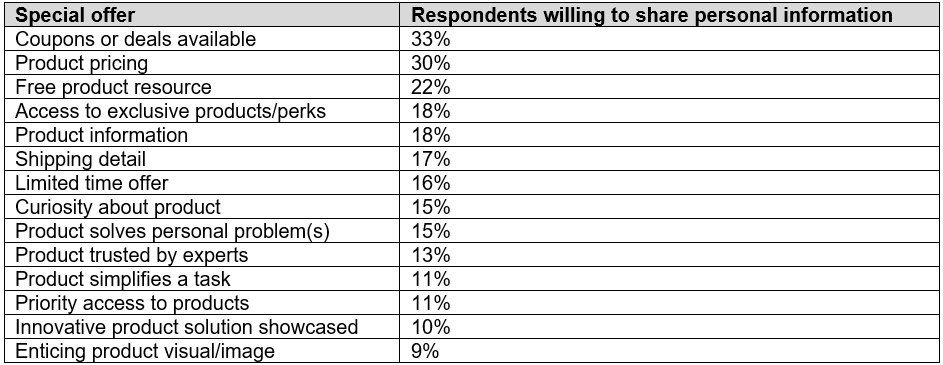Study Reveals Top Incentives for Collecting First-Party Data
William Skelly
Data, First-Party Data
February 12, 2024
Study Reveals Top Incentives for Collecting First-Party Data
Google is restricting the use of third-party cookies to track consumers’ activities from its Chrome web browser by third quarter 2024.[1] This move means first-party data will be even more important for advertisers, marketers, publishers and data providers.
A new study from Trade Desk Intelligence and YouGov shows consumers would be willing to share personal information with brands and retailers when motivated by special offers, discounts and other incentives.[2]
The study says 74% of respondents would share personal information in exchange for deals, sale prices and exclusive products from apparel, consumer packaged goods companies and retailers. The top motivators:[3]

Source: The Trade Desk Intelligence and YouGov Consumer CPG/Apparel Buying Behaviors Study 2023
Here are ideas for collecting first-party data from consumers:
1. Onboarding new customers New customers will share information as part of the welcome and onboarding process. Be sure to get key contacts across the client organization, their preferred communications methods, current systems and processes. Become very clear about the clients’ pain points, areas for improvement where your organization can offer solutions and how you can make their lives easier.
This information creates opportunities to personalize communications, streamline adoption of your products and services and strengthen your working relationship.
2. Rewards, incentives and loyalty programs Consumers willingly share their contact information and other data when they are incentivized with special deals, complimentary trials, exclusive offers, extra content, previews and early access.
Rewards and loyalty programs can offer points for purchase, website interaction or provide more data. Offer points and rewards for multiple purchases, deepening your organization’s relationships and increasing opportunities for cross-selling and upselling.
3. Customer surveys and feedback Regularly requesting feedback and customer surveys creates opportunities to understand your audiences’ needs, preferences and behaviors. This valuable information can be used to identify areas for improvement across your organization: sales, customer service, operations, logistics, product development and marketing strategies.
4. Social media engagement Pay close attention to conversations and engagement across social media. Not only what people are saying about your brand, but also the latest trends in your industry and the markets you serve.
Find out what channels your customers are using beyond the typical LinkedIn, Facebook and Instagram. Experiment with alternate platforms to attract new customers, including Reddit, What’s App and tech users’ forums. Consider ramping up social media advertising such as YouTube and LinkedIn.
You can see more tips in my article, “Five Best Practices for Collecting First-Party Data.”
By prioritizing first-party data collection, advertisers, marketers and publishers will minimize the impact of third-party cookie deprecation. Partner with a forward-thinking data consultant to optimize your customer data. Leveraging predictive and prescriptive modeling, we help our clients create strategies to attract new clients with relevant, impactful marketing campaigns. Reach out to learn more at [email protected].
William Skelly is founder and CEO of Causeway Solutions, a leading provider of Acquisition Analytics and innovative data services. Bill serves as advisor with some of the nation’s most influential organizations—from grassroots public affairs efforts to U.S. Presidential campaign strategies. Causeway Solutions empowers clients to make smart, timely, data-driven decisions through real-time consumer insights to better reach target audiences. Learn more at Causeway Solutions.
Sources:
[1]: “Preparing fo the end of third-party cookies,” Privacy Sandbox, Google for Developers
[2]: “74 percent of U.S. consumers are willing to share personal information with brands and retailers,” The Current
[2]: “74 percent of U.S. consumers are willing to share personal information with brands and retailers.”